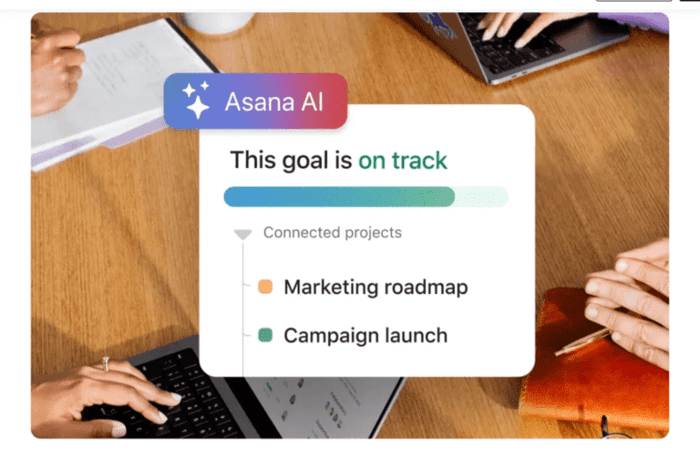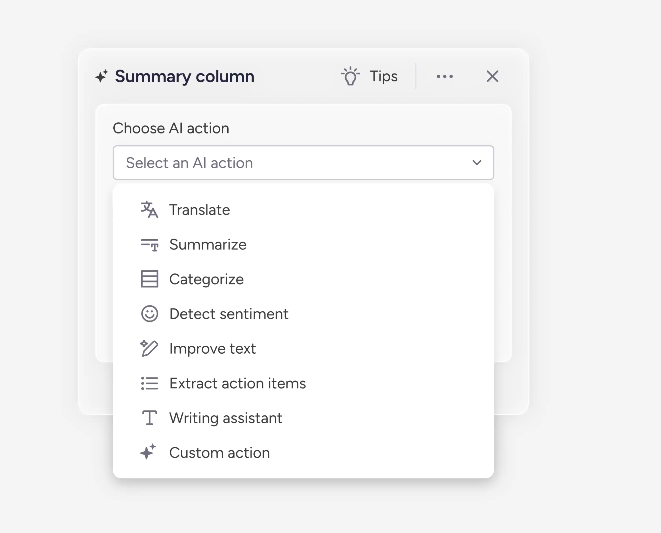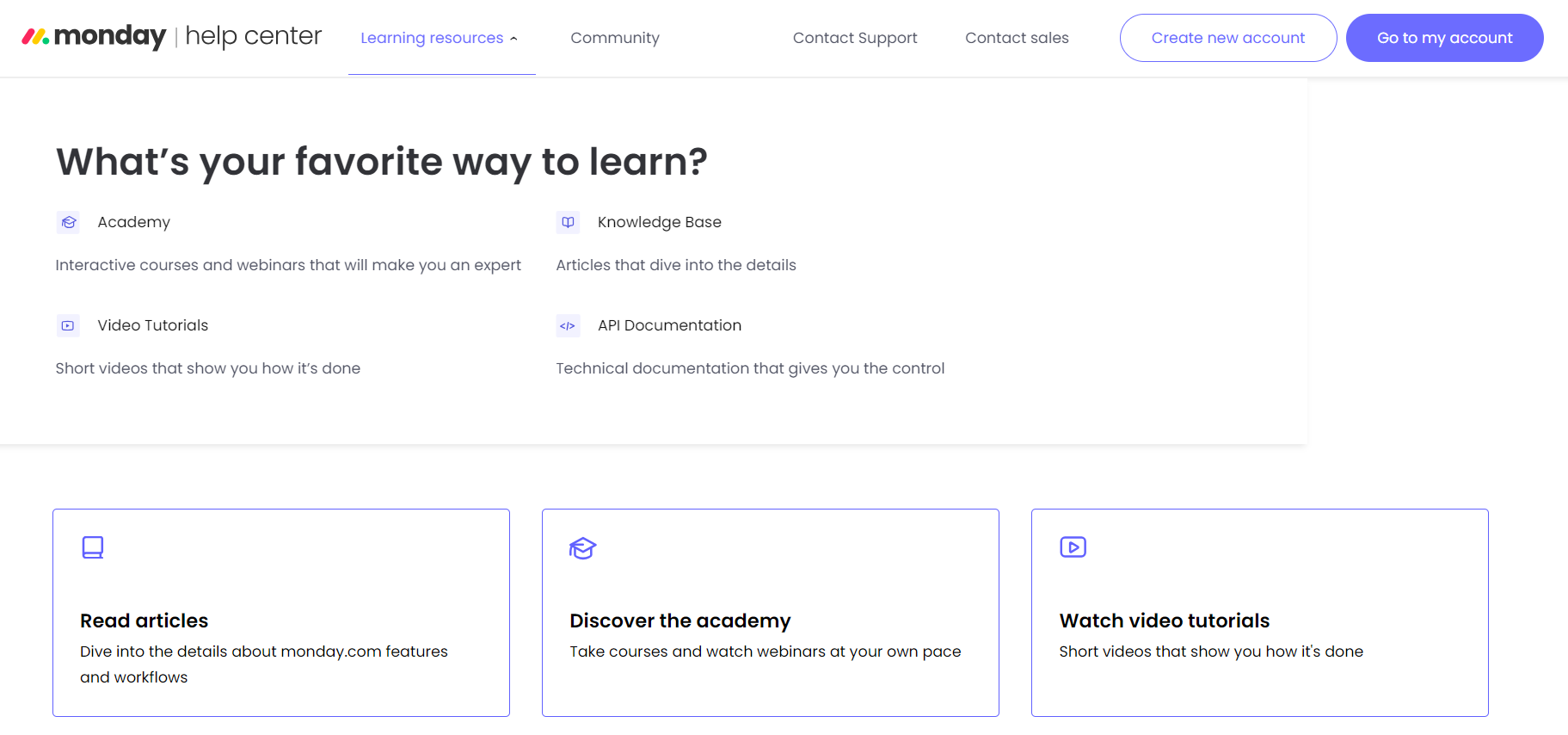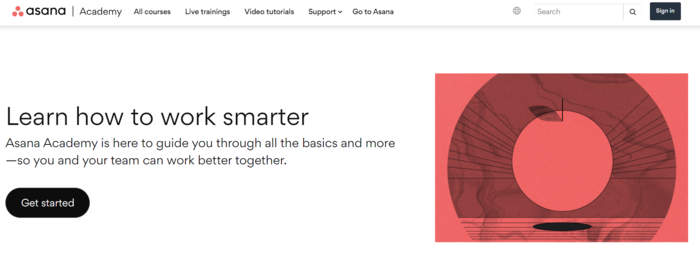When comparing Asana vs monday, both platforms are user-friendly and cost-effective project management software with automated features and transparent workflows. Despite the similarities, these platforms differ in pricing, key features, and user reviews. Although it’s a tie between the two on affordability and ease of use, Asana wins out for its features, while monday wins in customer support.
Based on our evaluation and expert opinion, we recommend each solution for the following:
- Asana: Best for small teams and solopreneurs working on individual projects.
- monday.com: Best for larger teams and multiple workspaces with ever-changing tasks.
Asana vs monday.com at a Glance
 | ||
|---|---|---|
Our Overall Rating out of 5 | 4.69 | 4.42 |
$10.99 | $9 | |
Free Plan | ✔ Up to 10 users | ✔ Up to 2 users |
Free Trial Period | 30-day free trial of the Starter or Advanced plan | 14-day free trial for Basic, Standard, and Pro plans |
Customer Support | ✔ | ✔ |
Ease of Use | Intuitive interface with live training and webinars | User-friendly column format is familiar to spreadsheet users |
Integrations | 270-plus integrations with commonly used applications | 200-plus integrations with popular workplace apps and platforms |
Automation | More automated features for paid subscriptions | Automation for Standard, Pro, and Enterprise plans |
Artificial Intelligence (AI) | Available on all paid plans | Available on Pro and Enterprise plans |
Best Alternatives to monday.com & Asana
Several Asana alternatives and monday.com alternatives have similar project management features. These software options offer multilevel workflow management at various starting prices and subscription sizes. When choosing a platform, consider your unique business needs, such as project type, team size, and communication expectations.
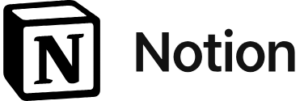 |  |  | |
|---|---|---|---|
Best For | Content planning | Automation and AI | Cross-functional collaboration |
Starting Monthly Price per User | $10.00 | ||
Most Affordable: Tie
 | ||
|---|---|---|
Our Price Rating out of 5 | 4.75 | 4.75 |
Free Plan | Forever free for up to 10 users | Free for up to 2 users |
User Minimum | 2 users | 3 users |
Annual Starting Price per User |
|
|
Monthly Starting Price per User |
|
|
Monthly Enterprise Pricing |
|
|
User Limits |
|
|
In comparing monday vs Asana, both platforms are tied for affordability. Each plan provides multiple subscription levels, beginning with free and scaling up to enterprise-level plans. For each platform, the pricing also changes based on monthly or annual subscriptions, with annual pricing being more affordable on a monthly basis.
With Asana, the forever-free personal plan is a good option for solopreneurs managing their workflow or small teams interested in trying out project tracking. Although the paid plans require a two-user minimum, the personal plan allows up to 10 collaborators. Asana also offers subscription models, or spaces, for different types of businesses.
In a monthly cost comparison, monday.com offers plans with more options and lower prices than Asana. However, monday.com subscriptions require a minimum of three users for paid plans, which can be prohibitive for solopreneurs. Overall, both platforms provide the best options for affordable project management software.
Best Project Management Features: Asana
 | ||
|---|---|---|
Our Key Features Rating out of 5 | 5 | 4.25 |
Task Management | Unlimited projects, tasks, and subtasks | Unlimited projects and tasks |
Project Dashboards | Only available on paid plans | Only available on paid plans |
Customization | Project customization and views to personalize your planning | 20-plus columns to create custom project boards |
Project Views | Offers diverse project overviews across user plans | Multiple views are only available for Standard, Pro, and Enterprise plans |
Kanban Boards | ✔ | ✔ |
Gantt Chart | ✔ | ✔ |
Calendar View | ✔ | ✔ |
Timeline View | ✔ | ✔ |
Files View | ✔ | ✔ |
Chart View | ✔ | ✔ |
List View | ✔ | Х |
Map View | Х | ✔ |
Although Asana and monday.com have many workplace solutions, the project management software provides several standard features across plans. Both Asana and monday.com include project dashboards for more transparent workflow management, such as assigning tasks and collaborating with team members.
When comparing platform features, Asana offers unlimited project views on its forever-free and starter plans, while monday.com has limited views. Both free and paid plans in Asana allow you to use free integrations from other platforms and apps, but you will need a paid plan for full access to all of monday’s integrations.
The number of project dashboards for both plans also corresponds to specific plans. While monday.com’s free plan offers customizable project dashboards, only Asana’s paid plans provide them. Both platforms offer diverse project views, like Gantt charts and Kanban boards, but Asana has fewer project views than monday.
While a free or introductory plan of Asana or monday is sufficient for solo users, teams of more than three users would be better served with a paid monday plan to access multiple views and more collaboration tools. However, Asana wins out in this category because it has a better bang for your buck and more features available to free and starter plan users.
Pro Tip: Use Kanban boards to set project priority levels. For example, use colors to indicate project status (e.g., red, yellow, green) or priority (e.g., low, medium, high). This style works well for agile teams, but Asana and monday accommodate many project management styles.
Best Advanced Features: Asana
 | ||
|---|---|---|
Our Advanced Features Rating out of 5 | 5 | 3.75 |
Built-in Time Tracking | Available on Advanced and Enterprise plans | Available on Pro and Enterprise plans |
Time-tracking Integrations | Allows free integrations in Personal and Basic plans | No free integrations |
Budget Tracking | Offers budget and expense tracking templates | Numbers columns and formulas provide accurate budgeting |
Automation | Automation workflows available for Standard, Advanced, and Enterprise+ plans | Automation workflows available for Standard, Pro, and Enterprise plans |
AI | Available on all paid plans | Available on Pro and Enterprise plans |
Resource Management | Capacity planning and reporting dashboards streamline workload management | Workload views and task assignments support project efficiency |
Cybersecurity | Multifactor authentication and SOC 2 keep customer data safe | Encrypted traffic and external audits improve data protection |
In addition to the standard features, both Asana and monday.com offer more advanced features for higher-tier subscriptions. However, Asana stands out for greater user access to automation, artificial intelligence, and time-tracking integrations across plans.
Automation is great for smaller teams without an on-staff project manager and larger teams with multiple moving parts. For example, Asana AI can send smart updates and answer project questions. monday.com also offers several artificial intelligence features, or AI actions, like language translation, but they’re only available for Pro and Enterprise subscriptions.
Another difference between Asana and monday is the access to integrations. Because built-in time tracking requires a paid plan, Asana allows integrations like Hubstaff to give teams time-tracking options without access to advanced features. In contrast, monday.com does not allow these integrations and only provides built-in time tracking for higher-tiered plans.
Both platforms also provide multiple levels of cybersecurity depending on your business needs. For example, Asana and monday.com offer compliance with privacy laws for Enterprise plans, which benefits businesses that handle sensitive data.
Two-factor authentication is also a standard feature for both platforms and is great for small businesses that handle client information or customer data. Regardless of size, both Asana and monday.com prioritize safety and security.
SOC 2 stands for Service Organization Control 2. This security feature helps to reduce the risk of data breaches by providing higher levels of safety compliance, audits, and security reports. There are two types of SOC 2, Type I and Type II, and both Asana and monday offer SOC 2 Type II, which includes routine security audits during a specific period to keep your data safe.
Best Customer Support: monday.com
 | ||
|---|---|---|
Our Support Rating out of 5 | 5 | 4.38 |
Help Center | Includes video tutorials, articles, and asynchronous courses | Includes live weekly trainings, webinars, and articles |
Customer Support | 24/7 for paid plans and general assistance via email, phone, and chat | 24/7 for Enterprise plans and via the Asana Support Bot for all customers |
Phone Support | ✔ | Х |
Email Availability | ✔ | Х |
Knowledge Base | ✔ | ✔ |
Live Chat | ✔ | ✔ |
Community Forum | ✔ | ✔ |
monday.com offers 24/7 customer support for paid plans via email, phone, and live chat. The monday.com Help Center also includes topic forums, video tutorials, and courses that are great for onboarding and navigating software issues. For social media users, monday’s Facebook community group provides peer support in a casual environment.
Similarly, Asana has many Help Center services, such as webinars, live training at Asana Academy, and community engagement via the Asana Forums. However, Asana does not provide direct email or phone support, and submitting support tickets can frustrate users with urgent issues. Priority support is only available for Enterprise users and is less far-reaching than the monday.com offerings.
Most User-friendly: Tie
 | ||
|---|---|---|
Our Usability Rating out of 5 | 5 | 5 |
Mobile App | ✔ | ✔ |
Built-in Templates | ✔ | ✔ |
User-friendly Interface | ✔ | ✔ |
Intuitive Adoption | ✔ | ✔ |
Accessibility | ✔ | ✔ |
Onboarding Assistance | ✔ | ✔ |
Asana and monday.com were designed with ease of use in mind. Aesthetically, Asana’s clean interface organizes tasks in clear lists and columns that are easy to navigate. If you have used a planner or task organizer, Asana’s format is like a digitized version of that same structure, with clear rows to record your tasks and due dates.
While it can be easy to lose track of tasks you can’t see, monday’s dynamic dashboards provide transparency and visual interest to collaborative teams. Both Asana and monday also incorporate customizable colors, photos, and labels to differentiate between users, tasks, and columns.
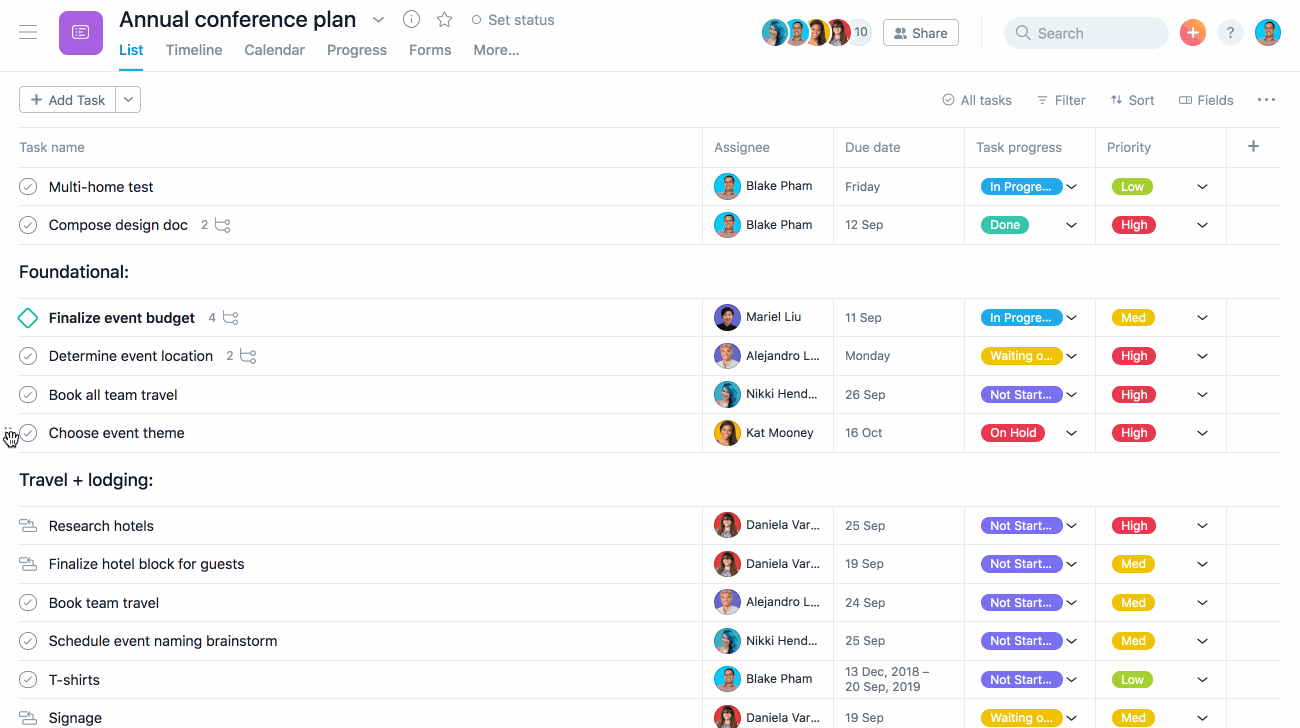
Use the list view to navigate and assign tasks. (Source: Asana)
Both platforms offer onboarding assistance for new users and employees. For example, Asana Academy hosts monthly live training sessions to help teams adopt Asana. The platform has also added custom onboarding features to its Enterprise plans that streamline adding guests and users.
Onboarding to monday.com is simplified with prerecorded webinars and guides. These items introduce helpful tasks and automation, allowing users to familiarize themselves with the software. Asana and monday also offer a mobile application to stay up to date with your projects on the go.
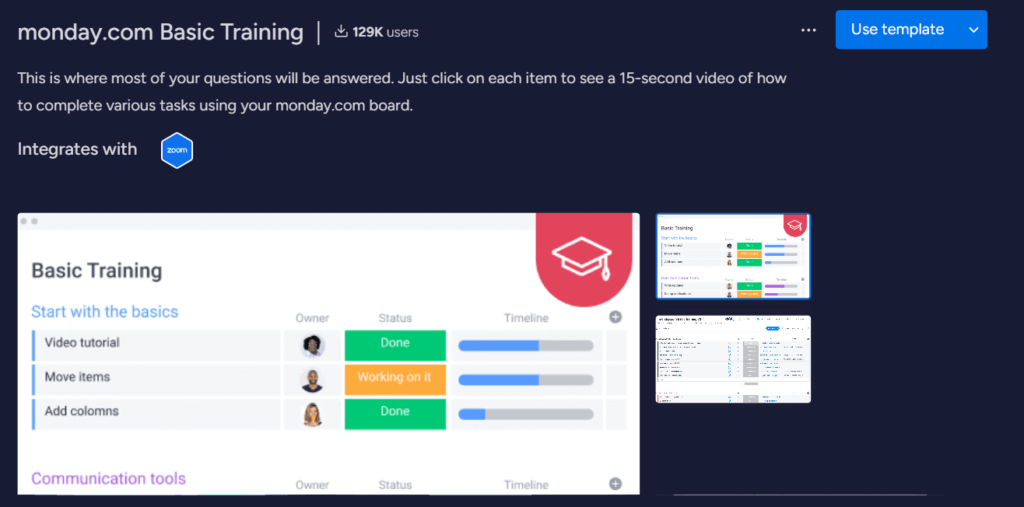
Get introduced to monday with Basic Training templates. (Source: monday.com)
Each platform provides robust libraries of prebuilt templates, decreasing the time spent creating new processes and designing project workflows. At the same time, Asana and monday.com are highly customizable for businesses that prefer a more personalized project plan or onboarding process.
At the same time, Asana’s lack of customer support features may make it more difficult for new users to address platform issues promptly. So, while ease of use is a tie, consider your need for on-demand assistance when choosing a subscription.
Both Asana and monday.com have integrated several methods to garner attention from new users, such as small business owners. For example, both platforms offer free trials and introductory plans for new users to test out the platforms in their businesses before committing to a monthly or annual subscription.
Asana and monday.com also include integrations that make transferring from one project management platform to another easier. For example, Asana has hundreds of integrations to diverse platforms for users who want to switch to the software or add it to their workspace management.
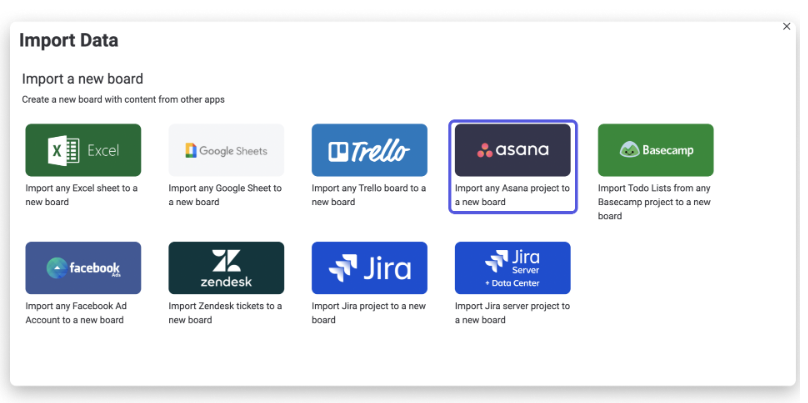
Move your projects to monday with the import tool. (Source: monday.com).
For users who want to move to monday, the software provides resources to import projects from other platforms, like Jira, Trello, and even Asana. These implementations make monday.com an attractive option for users who want a new platform without the hassle of manual data migration.
When adopting a new project management platform or methodology, it’s essential to analyze your business needs, focusing on any issues with current platforms or project delivery. For example, if you have problems with transparency, repetitive tasks, or communication, how would adopting a new tool help solve those problems?
Additionally, business owners already using a specific project management style, like Agile planning or the Waterfall method, should adopt a platform that complements their current methods while solving critical problems.
Expert Choice: Asana
 | ||
|---|---|---|
Rating out of 5 | 5 | 4.38 |
Accessibility | Provides in-depth training and digital resources | Provides extensive community and customer support |
Project Features | Offers subtasks and advanced artificial intelligence | Offers diverse project views and dashboard visualization |
Subscription Value | Requires at least 2 users | Requires at least 3 users |
User Reviews | 4.5 average | 4.6 average |
Learn More |
Asana and monday.com are excellent project management platforms for small business owners, but there are a few things to remember when comparing the two. Specifically, Asana and monday.com differ in terms of what types of projects and team sizes they benefit the most.
Working with Asana is especially effective for long-term project planning and tracking within a single workspace. In my experience, Asana works best for detail-oriented project tracking, such as content creation or to-do lists. Asana’s subtasks are also beneficial for more complex projects. However, the limitations in task assignment make it better suited for an individual or small team.
For example, monday.com allows users to assign tasks to an entire team, which is useful when working in a department or on a group project. In contrast, Asana only enables you to assign tasks to individuals. While this limitation can keep team members accountable for completing their projects, it doesn’t always work in collaboration-heavy workspaces.
Because of its breadth of collaborative features, monday.com is excellent for larger teams. Specifically, monday is most beneficial for managing multiple locations or departments within one space. The templates and automation are also ideal for customizing dashboards and assigning tasks and project roles.
These distinctions are borne out in the user reviews and common concerns about these platforms. Across review sites, Asana tends to have a lower star average than monday.com, with many users expressing concerns about the lack of on-demand assistance and limited features.
Despite its collaborative features, monday.com users express concerns about item and action limits, automation issues, and financial planning difficulties. While both platforms have benefits and limitations, Asana’s straightforward project management wins out in the expert score.
How We Evaluated Asana vs monday
In assessing the platforms, we considered the priorities of small business owners, specifically pricing, key features, customer support, and general ease of use. The evaluation concludes with an expert score that provides an opinion and overview of the best value in project management software.
20% of Overall Score
To determine the comparative pricing of these products, we examined the cost of the different tiers of monthly plans. Specifically, we looked at annual pricing and whether or not the provider offers free trials or forever-free plans, which can benefit solopreneurs and small teams.
25% of Overall Score
We assessed the types of task management, project views, and integrations available for the software. This category also focused on whether standard features were available on free plans or only for paid options.
20% of Overall Score
These features are generally available on higher-tier plans. Unlike general features, advanced features are not required for successful project management, but they would benefit a small business owner who wants to streamline workflows and increase productivity.
10% of Overall Score
Customer support was evaluated based on the depth and diversity of resources, such as 24/7 service, chatbot availability, and priority support for higher-tier plans.
10% of Overall Score
We evaluated ease of use based on how intuitive and user-friendly the software is for new users and how easy it is for project management pros to navigate.
15% of Overall Score
This includes our evaluation of the project management software’s overall benefits, such as its value for small business owners, and reflections on user adoption and reviews.
Frequently Asked Questions (FAQs)
monday.com offers an aesthetically pleasing interface that works well for teams that need highly customizable workspace management for cross-departmental collaboration and dynamic tasks. In contrast, Asana’s list and board format is excellent for timeline-specific tasks and in-depth project planning, such as long-term content management. Both Asana and monday provide valuable resources to beginner planners and experienced collaborators.
Yes, monday.com is excellent for small businesses that require a cost-effective and easy-to-use project management platform. monday offers free introductory plans, prebuilt templates, and intuitive software for solopreneurs and small teams. Additionally, monday’s diverse project views, automated tasks, and collaborative features work well for larger teams.
Moving from Asana to monday is a simple process using monday.com’s import tool. After signing up for a monday.com account, you can “Import data” from various platforms, such as Asana, Trello, and Jira. This tool will prompt you to sign in to your Asana account and connect it to monday.com before authorizing the platform to sync your data. Additionally, Asana integrations allow you to use both platforms by syncing your Asana account with monday.
Bottom Line
Asana and monday.com are great options for managing projects and collaborating with team members. In a side-by-side comparison, it’s a close call between Asana vs monday.com, with Asana winning out in features and the expert score. However, many small businesses can benefit from the variety of plans and customer support at monday.com.
Overall, which software you choose depends on your unique business needs. Despite the differences between plan pricing and features, both options suit Agile teams and small business owners looking to develop more efficient workflows. If you want to know more about each option, sign up for free trials of Asana or monday to see how well they work with your business.
